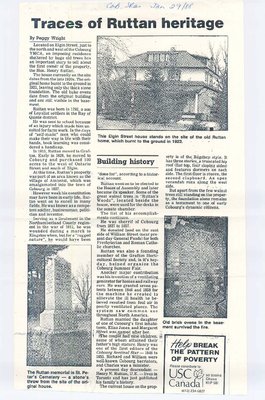By Peggy Wright
Located on Elgin Street, just to the north and west of the Cobourg YMCA, an imposing residence sheltered by huge old trees has an important story to tell about the first owner of the property, the Hon. Henry Ruttan.
The house currently on the site dates from the late 1920s.The original home burnt to the ground in 1922, leaving only the thick stone foundation. The old bake ovens date from the original building and are still visible in the basement.
Ruttan was born in 1792 a son of Loyalist settlers in the Bay of Quinte district.
He was sent to school because of an injury which made him unsuited for farm work. In the days of "self-made" men who could make their way in life with their hands, book learning was considered a handicap.
In 1815, Ruttan moved to Grafton. Early in 1828, he moved to Cobourg and purchased 100 acres to the west of Ontario Street and south of Elgin.
At this time, Ruttan's property was part of an area known as the village of Amherst, which was amalgamated into the town of Cobourg in 1837.
However weak his constitution may have been in early life, Ruttan went on to excel in many fields. He was known as a competent soldier, businessman, politician and inventor.
Serving as a lieutenant in the Northumberland County regiment in the war of 1812, he was wounded during a march to Kingston when, but for a "rugged nature would have been "done for", according to a historical account.
Ruttan went on to be elected to the House of Assembly and later became its speaker. Some of the great walnut trees in "Ruttan's Woods", located beside the house, were used for the desks in the senate chamber.
The list of his accomplishments continues.
He was sheriff of Cobourg from 1827to 1857.
He donated land on the east side of William Street (near present day General Foods) for both Presbyterian and Roman Catholic churches.
Ruttan was also a founding member of the Grafton Horticultural Society and, in its heyday, helped organize the Cobourg Summer Fair.
Another major contribution was his invention of a ventilating generator for homes and railway cars. He was granted seven patents between 1846 and 1858 for the machine he created to alleviate the ill health he believed resulted from foul air in poorly ventilated places. The system saw common use throughout North America.
Ruttan married the daughter of one of Cobourg's first inhabitants, Elias Jones, and Margaret Street was named after her.
The couple had nine children, some of whom attained their father’s high stature. Henry was one of the first editors of the Cobourg Sentinel Star – 1846 to 1855. Richard and William were well-known Cobourg barristers, and Charles was a minister.
A present day descendant – Henry N. Ruttan, U.E.-lives in Toronto and has just published his family's history.
The current house on the property is of the Regency, style. It has three stories, a truncated hip roof (flat top, four sloping sides) and features dormers on each side. The first floor is stucco, the second clapboard. An open verandah runs along the west side.
But apart from the few walnut trees still standing on the property, the foundation alone remains as a testament to one of early Cobourg's dynamic citizens.


